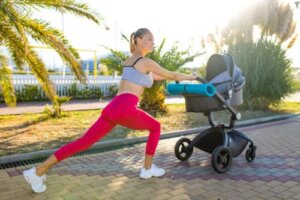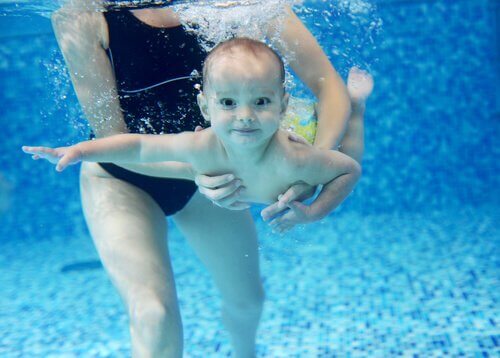Tips and Guidance for Exercising While Breastfeeding

After pregnancy, the baby is the undisputed priority, but recovering their figure also becomes one of the main objectives of many mothers. There are many questions regarding this topic, but you should know that breastfeeding and physical activity can be compatible. In this article, we’ll give you a series of tips for exercising while breastfeeding.
Breastfeeding and doing a proper workout brings many benefits after giving birth. The activity provides increased energy and helps keep the mind clear, while the release of endorphins causes a sense of well-being.
Weight loss and muscle strengthening won’t only help you look better, but will also help you cope with all your daily activities. The risks to the baby and mom are minimal. In addition, moderate exercise doesn’t affect milk production.
When to start and what activities to do?
After giving birth, you can start exercising immediately. But, be careful, they should be gentle activities. Keep in mind that you should wait about 6 weeks before you do more intense workouts. It’ll also depend on your physical condition.
Here are some activities that you can start gradually during breastfeeding:
- Postnatal gymnastics: This helps to tone the muscles that have relaxed as a result of the birth of the baby. It strengthens the abdominal area and the pelvic floor.
- Walking: This is a cardiovascular exercise that helps oxygenate the body and improve blood circulation. It’s easy to do, you enjoy being outdoors, and you can do it with your baby.
- Pilates and yoga: Both are compatible with postpartum activities. You should avoid some postures that put a lot of pressure on the pelvic floor. These classes are ideal for regaining flexibility and correcting posture.
- Swimming: This is one of the most complete low-impact exercises. It’s best to wait until the puerperium stage is over. Early activity has the risk of causing puerperal endometritis, which is an infection of the uterus. Once this phase is over, swimming helps to tone the abdominal area and the lumbar region. Matroswimming is a recommended activity to do with your child.
- Bicycling: It’s advisable to wait about two months before starting to cycle again. After that time, it’s undoubtedly a good option to improve the circulatory system and strengthen the muscles. It’ll also help you lose weight and achieve greater endurance.

You might be interested in: Women Need a Year to Recover After Childbirth
Tips to keep in mind when exercising while breastfeeding
Breastfeeding and doing moderate activity is low risk, both for the mother and the baby. If you’re a professional athlete, you can give it a little more intensity.
In all cases, it’s best to consult your doctor. Here are some tips to help you enjoy exercising while breastfeeding.
Avoid very intense activity
It’s best to avoid any activity that involves risks of trauma to the breasts. Be careful with contact sports or those where there’s a danger of falling.
Also, pay attention to the loads you use if you’re going to exercise with weight. Training too hard could lead to breast infection and a decrease in breast milk supply.
That’s why it’s a good idea to pace yourself and avoid fatigue. In case of dizziness, shortness of breath or increased vaginal bleeding, stop exercising.
Wear comfortable clothing
Wearing appropriate clothing is important for sports in all conditions. Choose a comfortable sports bra, which keeps the breasts firm, but doesn’t fit too tightly.
One of the main problems is if mastitis occurs, which is inflammation in the breast tissue. On the other hand, exercising after breastfeeding is more appropriate. As the breasts aren’t full, you can move comfortably.
Stay well hydrated
Drinking plenty of water is essential in order to maintain breast milk production. It’s key to do it during the activity and also once it’s over.
Drinking at least 2 liters of water daily would be good at this stage. In addition, you can also drink natural juices or infusions.
However, energy drinks aren’t recommended. They could have negative effects on your health and reach the baby through the milk.
Eat a healthy diet
A good diet is essential to get all the benefits of exercise. Consult a nutritionist for a proper plan.
A study published in 2013 suggests that diet and exercise together are more effective than diet alone in helping women lose weight after childbirth. Exercise improves the maternal cardiorespiratory fitness level, while diet alone reduces fat-free mass without boosting cardiovascular fitness.

Exercise with your little one
Sometimes, in order to devote time to certain activities, you must first figure out who will care for the child. However, there are some activities you can share with your baby.
For example, going for a walk is something you can do with your baby in your arms, in the sling or in the stroller. There are also special yoga classes and various exercises, such as squats, push-ups, crunches, and planks, among others, that you can do at home.
Read also: The Keys to Firming Your Abdomen in the Postpartum Period
The benefits of exercising while breastfeeding
Physical activities in the breastfeeding stage help a better postpartum recovery and contribute to physical and emotional well-being. There are no contraindications to doing exercise, quite the opposite in fact.
Keep in mind that the taste of the milk might change a bit, due to the increase of lactic acid. But, in most cases, babies tolerate it well.
These are some of the main benefits of exercise during breastfeeding:
- Minimizes stress and anxiety
- Improves the cardiovascular system
- Reduces pain and fatigue
- Provides greater flexibility and balance
- It favors the deposit of calcium in the bones
- It reduces the volume of fat accumulated during pregnancy
Have a great experience together with your baby!
Physical activity isn’t only compatible with the breastfeeding stage, it’s recommended. However, it’s best to start slowly and with gentle exercise.
Milk production won’t be affected and, although the taste of the milk may change a little, the baby will be able to tolerate it fine.
There’s a wide range of possible activities to do. And best of all, you can share many of these workouts with your child. This will help strengthen your bond with your child, as well as giving you a unique experience.
All cited sources were thoroughly reviewed by our team to ensure their quality, reliability, currency, and validity. The bibliography of this article was considered reliable and of academic or scientific accuracy.
-
Amorim AR, Linne YM, Lourenco PM. Diet or exercise, or both, for weight reduction in women after childbirth. Cochrane Database Syst Rev. 2007 Jul 18;(3):CD005627. doi: 10.1002/14651858.CD005627.pub2. Update in: Cochrane Database Syst Rev. 2013;7:CD005627. PMID: 17636810. Disponible en: https://pubmed.ncbi.nlm.nih.gov/17636810/
-
Lee LL, Huang SF, Lai PC, Huang YT. Effect of exercise on slowing breastfeeding-induced bone loss: A meta-analysis and trial sequential analysis. J Obstet Gynaecol Res. 2020 Sep;46(9):1790-1800. doi: 10.1111/jog.14346. Epub 2020 Jul 8. PMID: 32643316.Dsiponible en: https://pubmed.ncbi.nlm.nih.gov/32643316/
This text is provided for informational purposes only and does not replace consultation with a professional. If in doubt, consult your specialist.








